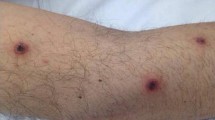Abstract
A case of disseminated infection with Fusarium oxysporum following chemotherapy of acute myelogenous leukemia is reported. Antifungal treatment was successful with a 13-day course of oral terbinafine 250 mg t.i.d. in combination with amphotericin B deoxycholate 1.0–1.5 mg/kg qd and subsequently intravenous liposomal amphotericin B 5 mg/kg qd. Preceding monotherapy with amphotericin B deoxycholate 1.0–1.5 mg/kg qd had not stopped the progression of infection. The combination therapy described here represents a novel approach to the treatment of Fusarium spp. in the immunocompromised host in whom Fusarium spp. are known to cause disseminated infection with high mortality.




Similar content being viewed by others
References
Anaissie EJ, Kuchar RT, Rex JH, Francesconi A, Kasai M, Muller FM, Lozano-Chiu M, Summerbell RC, Dignani MC, Chanock SJ, Walsh TJ (2001) Fusariosis associated with pathogenic Fusarium species colonization of a hospital water system: a new paradigm for the epidemiology of opportunistic mold infections. Clin Infect Dis 33:1871–1878
Boutati EI, Anaissie EJ (1997) Fusarium, a significant emerging pathogen in patients with hematologic malignancy: ten years’ experience at a cancer center and implications for management. Blood 90:999–1008
Walsh TJ, Groll AH (1999) Emerging fungal pathogens: evolving challenges to immunocompromised patients for the twenty-first century. Transpl Infect Dis 1:247–261
Hennequin C, Abachin E, Symoens F, Lavarde V, Reboux G, Nolard N, Berche P (1999) Identification of Fusarium species involved in human infections by 28S rRNA gene sequencing. J Clin Microbiol 37:3586–3589
Guarro J, Gene J (1995) Opportunistic fusarial infections in humans. Eur J Clin Microbiol Infect Dis 14:741–754
Pujol I, Guarro J, Gene J, Sala J (1997) In-vitro antifungal susceptibility of clinical and environmental Fusarium spp. strains. J Antimicrob Chemother 39:163–167
Speeleveld E, Gordts B, Van Landuyt HW, De Vroey C, Raes-Wuytack C (1996) Susceptibility of clinical isolates of Fusarium to antifungal drugs. Mycoses 39:37–40
Warnock DW (1998) Fungal infections in neutropenia: current problems and chemotherapeutic control. J Antimicrob Chemother 41:95–105
Espinel-Ingroff A (1998) In vitro activity of the new triazole voriconazole (UK-109,496) against opportunistic filamentous and dimorphic fungi and common and emerging yeast pathogens. J Clin Microbiol 36:198–202
Arikan S, Lozano-Chiu M, Paetznick V, Rex JH (2002) In vitro synergy of caspofungin and amphotericin B against Aspergillus and Fusarium spp. Antimicrob Agents Chemother 46:245–247
Letscher-Bru V, Campos F, Waller J, Randriamahazaka R, Candolfi E, Herbrecht R (2002) Successful outcome of treatment of a disseminated infection due to Fusarium dimerum in a leukemia patient. J Clin Microbiol 40:1100–1102
Espinel-Ingroff A (1998) Comparison of in vitro activities of the new triazole SCH56592 and the echinocandins MK-0991 (L-743,872) and LY303366 against opportunistic filamentous and dimorphic fungi and yeasts. J Clin Microbiol 36:2950–2956
Pfaller MA, Marco F, Messer SA, Jones RN (1998) In vitro activity of two echinocandin derivatives, LY303366 and MK-0991 (L-743,792), against clinical isolates of Aspergillus, Fusarium, Rhizopus, and other filamentous fungi. Diagn Microbiol Infect Dis 30:251–255
Del Poeta M, Schell WA, Perfect JR (1997) In vitro antifungal activity of pneumocandin L-743,872 against a variety of clinically important molds. Antimicrob Agents Chemother 41:1835–1836
Johnson LB, Kauffman CA (2003) Voriconazole: a new triazole antifungal agent. Clin Infect Dis 36:630–637
Ryder NS (1999) Activity of terbinafine against serious fungal pathogens. Mycoses 42 [Suppl 2]:115–119
De Pauw BE (2000) New antifungal agents and preparations. Int J Antimicrob Agents 16:147–150
Acknowledgements
The authors thank Gottfried Weidinger MD, Novartis Pharma, 90429 Erlangen, Germany and Jannick Denouël MD, Novartis Pharma SA, 92500 Rueil-Malmaison, France for the determination of terbinafine plasma concentrations.
Author information
Authors and Affiliations
Corresponding author
Rights and permissions
About this article
Cite this article
Rothe, A., Seibold, M., Hoppe, T. et al. Combination therapy of disseminated Fusarium oxysporum infection with terbinafine and amphotericin B. Ann Hematol 83, 394–397 (2004). https://doi.org/10.1007/s00277-003-0795-x
Received:
Accepted:
Published:
Issue Date:
DOI: https://doi.org/10.1007/s00277-003-0795-x




